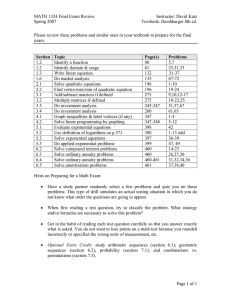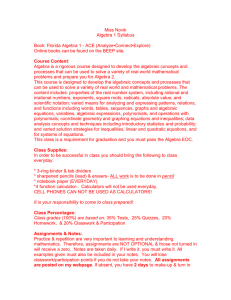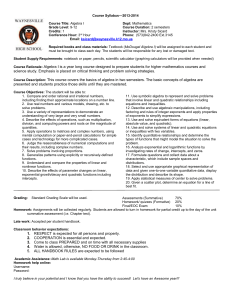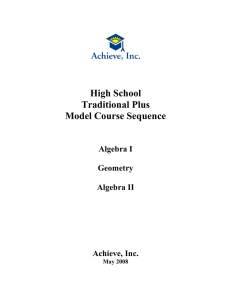Algebra for Elementary School Teachers
advertisement
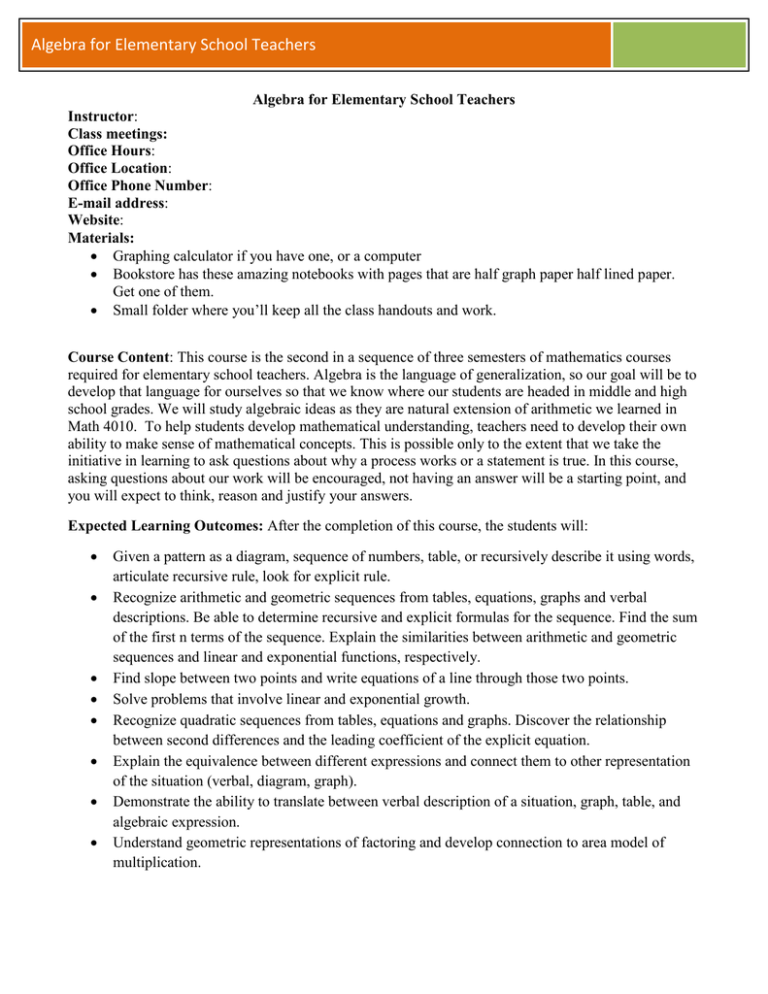
Algebra for Elementary School Teachers Algebra for Elementary School Teachers Instructor: Class meetings: Office Hours: Office Location: Office Phone Number: E-mail address: Website: Materials: • Graphing calculator if you have one, or a computer • Bookstore has these amazing notebooks with pages that are half graph paper half lined paper. Get one of them. • Small folder where you’ll keep all the class handouts and work. Course Content: This course is the second in a sequence of three semesters of mathematics courses required for elementary school teachers. Algebra is the language of generalization, so our goal will be to develop that language for ourselves so that we know where our students are headed in middle and high school grades. We will study algebraic ideas as they are natural extension of arithmetic we learned in Math 4010. To help students develop mathematical understanding, teachers need to develop their own ability to make sense of mathematical concepts. This is possible only to the extent that we take the initiative in learning to ask questions about why a process works or a statement is true. In this course, asking questions about our work will be encouraged, not having an answer will be a starting point, and you will expect to think, reason and justify your answers. Expected Learning Outcomes: After the completion of this course, the students will: • • • • • • • • Given a pattern as a diagram, sequence of numbers, table, or recursively describe it using words, articulate recursive rule, look for explicit rule. Recognize arithmetic and geometric sequences from tables, equations, graphs and verbal descriptions. Be able to determine recursive and explicit formulas for the sequence. Find the sum of the first n terms of the sequence. Explain the similarities between arithmetic and geometric sequences and linear and exponential functions, respectively. Find slope between two points and write equations of a line through those two points. Solve problems that involve linear and exponential growth. Recognize quadratic sequences from tables, equations and graphs. Discover the relationship between second differences and the leading coefficient of the explicit equation. Explain the equivalence between different expressions and connect them to other representation of the situation (verbal, diagram, graph). Demonstrate the ability to translate between verbal description of a situation, graph, table, and algebraic expression. Understand geometric representations of factoring and develop connection to area model of multiplication. Algebra for Elementary School Teachers • • • • • Know how to optimize a quadratic function and understand this in terms of symmetry, completing the square, and the quadratic formula. Explain how the order of a polynomial influences the shape of the graph by discussing their end behavior. Be able to explain the connections between polynomials and place value. Explain the similarities between long division of numbers and of polynomials. Articulate similarities between inverse operations and inverse functions. Find inverse functions of given linear, and exponential function. Explain why the domain of quadratic function needs to be restricted in order for it to be invertible. Solve systems of equations using algebraic and geometric methods. Methods of teaching and learning: Almost every day during class, you will be working in groups on various activities. Expect to turn these in at any time during class. I expect you to come to every class on time, turn assignments when they are due, participate actively in classroom discussions and activities, and take notes in class. Because you are preparing to be a teacher, your participation needs to reflect professional learning. This means it will not just be judged on the basis of its content but also on the basis of its form: You will need to speak audibly, connect with your audience, modulate the words you utter, and use standard English. I will give you feedback on what you say and on how you say it, in the understanding that it matters to you because so much of our work as teachers includes speaking for others to understand us. For the reason that you need to be prepared to think on your feet and talk in public you should expect to be called on even when you don’t volunteer. It is fair game (and deserves all our respect) if you ask for time to think about something or if you say, I don’t know but here is how I would find out. For the same reason, I expect you will give me feedback when I speak in ways that are difficult to understand or to hear and that you will accept that at times I also need to regroup and think for a while. Evaluation methods and criteria: • Tests: The class test is tentatively scheduled for February 7th and March 28th. If any changes need to be made in this schedule, they will be announced in class a week prior to the test date. • Assignments: • Throughout the semester you will be submitting individual and group work. Written work will be graded on four aspects: your understanding of the question, your explanation, your justification, and your answer. The first and last of these are worth a few points each, but most of the points are split between your explanation and justification. Explanation includes clarity and grammar as well as mathematical detail about what you did, what variables you used, and so forth. The level of justification we require will vary, but you should try to provide as complete a proof as you can. Each assignment will be announced a week ahead of its due date. • Certain assignments will have to be corrected and resubmitted. You will generally have to resubmit the assignment in class immediately following the one when the assignment was handed back. All work you submit must be yours! If I have any doubts about the origin of the work, I will not assign it a grade. • Final Project: Very often students tend to associate mathematics with worksheets, plug and chug exercises and endless repetition of things that were shown to them. The goal for the final Algebra for Elementary School Teachers • • project is for you to break these prejudices! The task is to use your creative side to teach and show what you’ve learned in this class. It will be due on December 9th for a class presentation. Final Examination: The cumulative final exam is scheduled on Tuesday, April 30, 2013 1:00 – 3:00 pm in LCB121. Grading Scale: The grade scale will be the usual: A (93-100), A- (90-92), B+ (87-89), B (83-86), B- (80-82), C+ (77-79), C (73-76), C- (70-72), D+ (67-69), D (63-66), D- (60-62), E (0-59). Assignments Midterms Participation Final project Final exam TOTAL 20% 30% 10% 15% 25% 100% 4. Short overview of the class: Week 1, 2 3, 4 5, 6 7, 8 9, 10 11, 12 13 14 15 Date 1/7 – 1/17 1/21 – 1/31 2/4 – 2/14 2/18 – 2/28 3/4 – 3/ 21 3/25 – 4/4 4/8 – 4/11 4/15 – 4/18 4/22 – 4/25 4/30 Topic Sequences Functions Change Linear functions Exponential functions Quadratic functions Polynomials Inverses Systems Final Exam 5. ADA Statement: The University of Utah seeks to provide equal access to its programs, services and activities for people with disabilities. If you will need accommodations in the class, reasonable prior notice needs to be given to the Center for Disability Services, 162 Olpin Union Building, 581-5020 (V/TDD). CDS will work with you and the instructor to make arrangements for accommodations. All information in this course can be made available in alternative format with prior notification to the Center for Disability Services. 6. In case you need it, but I hope you don’t: Last day to drop the class is 1/16, and last day to withdraw from the class is 3/1. 7. Welcome!
